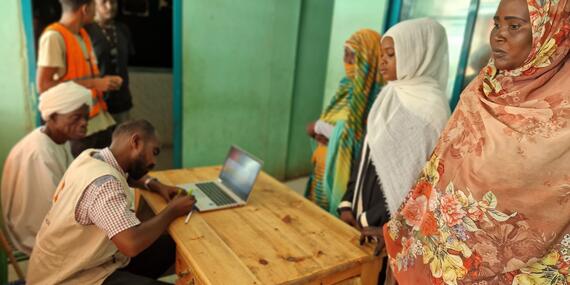Sudan: Supporting hundreds of displaced families with cash assistance

by Alimbek Tashtankulov, Sudan
Three women displaced from Omdurman, in Sudan’s Khartoum State, wait patiently for their turn in a room at Gedaref City Municipality, which the Norwegian Refugee Council (NRC) turned into a cash assistance distribution point. The women show their IDs to NRC staff, sign the required forms and receive 177,100 Sudanese pounds (US$275), provided by NRC thanks to funding from the Sudan Humanitarian Fund.
As the displaced women receive the cash, their tense facial expressions become softer, with a faint smile.
One said: “I will buy cooking pots, plates, cups and some mats for my family with this money.”
Tucking the money into her bag, another woman said: “I will buy some shading and fix the roof of the room where we are staying, and also buy pots, cooking utensils and some buckets for water.”
The third woman was there to receive the money on behalf of her family, as her father and mother are old and could not come. She said they would buy mats, plastic sheeting, cooking supplies and charcoal. She added: “We are a large family, my father, mother, brother and sisters, and their children. We will make more space for us by putting up some poles and covering them with plastic sheets to protect us from the sun.”
Since fighting between the Sudanese Armed Forces and the Rapid Support Forces erupted in April, an estimated 4.9 million people have been displaced in Sudan, according to the International Organization for Migration. These internally displaced people (IDPs) have sought refuge in about 5,200 locations across all of Sudan’s 18 states. Those displaced are from eight states, with the majority — about 3.3 million people (68 per cent of all IDPs) — originally from Khartoum. About 511,200 of the newly displaced people are in the eastern states of Gedaref, Kassala and Red Sea.
Muhammed Abdlqayum, NRC’s Shelter Team Leader for eastern Sudan, explained: “We are targeting 400 families [an estimated 2,400 people] in two localities in Gedaref State, Ar Rahad and Madinat [Baladia]. This $550 cash assistance is distributed in two rounds; after we complete this first round of distribution, there will be another post-distribution round after 30 days, where the monitoring is done to make sure that the cash assistance has been used for the right purpose, and then we provide the second installment.”
Susan Mulievi, an Area Manager at NRC’s east area office, said they are planning for the second round of distribution to take place in November.
NRC decided to use cash for NFIs and shelter assistance because it is more effective, faster, and easier to control and meet people’s needs. Distributing in-kind supplies would require importing those items from overseas, as Sudan’s production and supply chains are disrupted by the conflict. NRC officials explained that this would be a lengthy and more expensive process.
Phyllis Wanja, an Area Support Manager for NRC in eastern Sudan, said that NRC advocates for cash assistance for shelter and NFIs, but also for other needs and clusters.
“With cash assistance, the people we are aiming to support, especially with multi-purpose cash, can get what they actually need and based on what their priorities are,” she said.
Between April and 30 September 2023, the UN and humanitarian partners reached about 4.1 million people across Sudan with life-saving assistance and 5.3 million people with livelihood support. About 210,300 people received emergency shelter and NFIs.
However, a lack of funding is constraining partners’ ability to reach more people with assistance. As of 8 November, the revised 2023 Sudan Humanitarian Response Plan is only 33.6 per cent funded, with $862.3 million received, according to the Financial Tracking Service. Funding for the shelter and NFIs cluster is about $83.7 million, which is only 39 per cent of the cluster’s total requirement.
